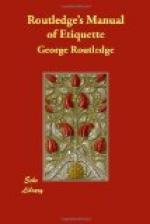You should clasp your partner lightly but firmly round the waist with your right arm.
Your left hand takes her right hand; but beware of elevating your arm and hers in the air, or holding them out straight, which suggests the idea of windmills.
Above all, never place your left hand on your hip or behind you. In the first place, you thus drag your partner too much forward, which makes her look ungraceful; in the next, this attitude is never used except in casinos, and it is almost an insult to introduce it in a respectable ball-room.
Let the hand which clasps your partner’s fall easily by your side in a natural position, and keep it there. Your partner’s left hand rests on your right shoulder; her right arm is thrown a little forward towards your left.
The Polka is danced in 2/4 time. There are three steps in each bar; the fourth beat is always a rest. The rhythm of the dance may be thus indicated:—
[Illustration]
the three steps being performed on the three first beats of every bar. It is next to impossible to describe in words the step of the Polka, or of any circular dance: nothing but example can correctly teach it; and, although we shall do our best to be as clear as possible, we would earnestly recommend those of our readers who desire to excel, whether in this or the following dances, to take a few lessons from some competent instructor.
The gentleman starts with his left foot, the lady with her right. We shall describe the step as danced by the gentleman: the same directions, reversing the order of the feet, will apply to the lady.
1st beat.—Spring slightly on right foot, at the same time slide left foot forward.
2nd beat.—Bring right foot forward by glissade, at the same time rising left foot.
3rd beat.—Bring left foot slightly forward and fall upon it, leaving right foot raised, and the knee slightly bent, ready to begin the step at the first beat of the next bar.
4th beat.—Remain on left foot. Begin next bar with the right foot, and repeat the step to end of third beat. Begin the following bar with left foot; and so on; commencing each bar with right or left foot alternately.
The Polka is danced with a circular movement, like the Valse; in each bar you half turn, so that, by the end of the second bar, you have brought your partner completely round.
It was at first customary to promenade your partner round the room, doing a kind of balancez to each other in the Polka step before commencing the valse figure. But this fashion soon became antiquated, and has fallen into complete disuse.
The circular movement of the Polka admits of two directions—from right or left or from left to right. The ordinary direction is from right to left. The opposite one is known as the reverse step. It is more difficult to execute, but is a pleasant change for skilled dancers, if they have become giddy from turning too long in one direction.




